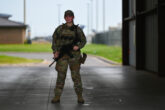June 28, 2007
CNAS Launch: The Future of U.S. Ground Forces
Dr. John J. Hamre moderated the discussion of the CNAS report “Shaping U.S. Ground Forces for the Future: Getting Expansion Right,” written by Michèle Flournoy and Tammy Schultz.
Flournoy provided an overview of the report, which is the first in a CNAS series on the Future of the U.S. Military, and commentators retired General Michael Hagee and Dr. Michael O’Hanlon provided an array of examples of considerations for the military’s future operating environment. The report highlights the unprecedented strain on the All-Volunteer Force, and the rare opportunity to shape the force for the future that expanding the ground forces by nearly 100,000 presents. Getting the mix of capabilities (shape) right, said Flournoy, is more important than the end strength number (size). Since future operations will present a wide variety of challenges, the future force must truly become full spectrum, which among other things will mean increasing irregular warfare capabilities. General Hagee discussed things that have not changed on the battlefield, such as confronting a thinking enemy, as well as some things that have changed, like the enemy not wearing a uniform. He also stressed the importance of having a national debate over the role of the National Guard and Reserves. O’Hanlon said that expanding the ground forces somewhat in the short-term made sense even with a drawdown in Iraq due to easily imaginable scenarios that would require U.S. forces, ranging from Darfur to Pakistan. Dr. Hamre concluded the session by observing that issues regarding quality versus quantity, the priority given to equipment and modernization, and the operational versus institutional Army needed further analysis and debate.
More from CNAS
-
National Security Human Capital Program
Short SupplyExecutive Summary The U.S. military faces a critical challenge: Fewer young Americans are willing to serve, and fewer adults are encouraging them to do so. Because of delibera...
By Katherine L. Kuzminski & Taren Sylvester
-
National Security Human Capital Program
Defending the Army’s Command Assessment ProgramThe concept for CAP — developed during the first Trump administration — benefited from the guidance, input and oversight from the foremost scholar and practitioner on military...
By Katherine L. Kuzminski
-
National Security Human Capital Program
‘Women Don’t Just Achieve…They Excel’: Fmr. Marine Corps Attack PilotDr. Kyleanne Hunter, former Marine Corps attack pilot and CEO of Iraq & Afghanistan Veterans of America, says “women are the fastest growing group of veterans” and “the fastes...
By Dr. Kyleanne Hunter
-
National Security Human Capital Program
A Workforce Strategy for America’s Shipbuilding FutureThe future of American maritime dominance will not be determined solely by the number of ships launched or contracts signed, but rather by the strength and sustainability of t...
By Katherine L. Kuzminski & Laura Schmiegel




